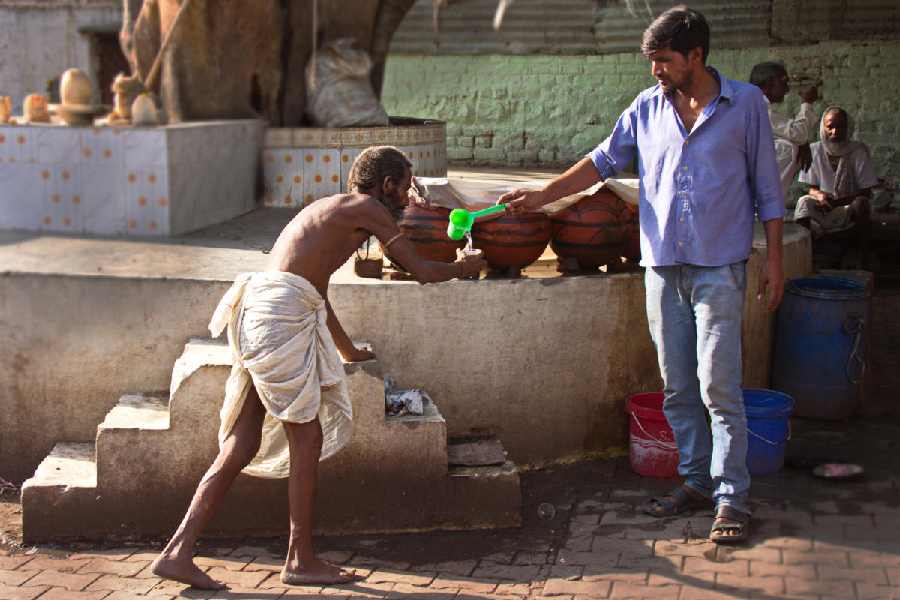|
|
It is said that after Uttam Kumar appeared opposite a daughter of the Rambagan Dutt family in a film titled Tasher Desh, he often used to be invited to tea at the Loudon Street home of this raving beauty, who, by the way, was older than the only matinee idol Bengali cinema has ever produced. While they partook of tea, Uttam Kumar, much to the glee of the leading lady’s three little daughters, would ask their mother to “passh the shugar pleesh”.
This story about the inability of the Bengali tongue to distinguish between s and z — like the equally famous one of the “cool brij over Howrah breez” — may be entirely apocryphal, but it does make a point. In a society obsessed with caste and class, knowledge of, and the ability to speak, English in the right accent immediately placed one in the upper echelons, just as the failure to do so would relegate the unfortunate to the Benglish limbo. Remember, those were times when Bengali heroes used to sport ulsters when they were shot in Chowringhee just to prove that they were with it. Such was Calcutta’s watertight, hierarchical society till the late Sixties, when the exodus of Anglo-Indian teachers marked the end of accent-and-enunciation snobbery and the beginning of a more egalitarian era, which gradually slipped into our times, when Hinglish has become the parlance even in Bengali homes.
This trend has a bearing, however oblique, on the opening of Big Bazaar, the “Behesht of brummagem” (everything showy and cheap, derived from Birmingham), in the Metropolitan Building on Chowringhee, which once housed Whiteaway Laidlaw & Co, Ltd, the poshest and classiest department store this side of the Suez. The façade of the building, which was accorded heritage status by the Calcutta Municipal Corporation, was once scarred and pitted, and coated with soot, with parasitical plants growing out of every nook and cranny. But the floors were still paved with marble and the windows were all stained glass.
Now the façade is cleaner but all the marble is gone and the stained glass was smashed when the ground and first floor were being turned into a shopping mall. The famous stained-glass atrium had collapsed years ago and there is a large gap in the roof. Water still leaks through the terrace, and when it rains it pours inside, flooding the two wooden staircases and flats. The Life Insurance Corporation of India owns the building and has never thought it worthwhile to get it thoroughly repaired. Little puddles also form on the wooden floor of the flat occupied by the eldest daughter of that actress, who had also famously played the role of Henriette in Utpal Dutt’s film on Michael Madhusudan. Rising damp and rainwater does not spare anybody. Now, though the rest of the building looks shabby and decrepit, Big Bazaar, which has opened on the ground (once occupied by the American Center library and auditorium, a favourite haunt of all those who sought refuge from the midday heat) and first floors, looks as if it has just emerged from wrappers.
Everything about it is brand new, from the false ceiling to the staircase, floors and window panes. Bullnose awnings, typically in blue and orange, shade the entrances on the Chowringhee and S.N. Banerjee Road sides. The clientele is Johnny-come-lately, essentially middle class, the type of person who would have been parsimonious even a decade ago. Suddenly he is letting himself go.
I had heard from a friend in Mumbai, who lived close to a Big Bazaar, about how people from the suburbs would arrive in droves by train to raid the mall on weekends. This was their idea of an affordable family outing in air-conditioned comfort, with the kiddies having a full run of the vast shop-floor in the trolleys laden with goodies. These tykes often used a trolley as a skateboard. In Calcutta they do the same, and their mothers would have followed suit, given half a chance. For this is just the place to let one’s hair down, and it’s not just the middle class that visits Chowringhee Big Bazaar. The shoppers are classless — and numberless too. Even the up-country security man (to use a euphemism) from the crumbling mansions and innumerable offices of the neighbourhood drops by with his bahu not just to gape at the white goods and the “International food” counter, or to prod the myriad packets of foodstuff, but actually to buy kitchen utensils (buy two get one free), “imitation” jewellery and bed linen for which there is a mad scramble. There is a books corner where colourful stationery is sold along with bestsellers, and people who never had a high opinion of book knowledge finger the pages.
This is the best time these crowds have had in their lives. A man with a loudhailer announced the latest items available at rock-bottom rates. Muslim women in burqas could not wait to lay their hands on the goodies, and arthritic Bengali Hausfrauen were undeterred by the steep and slippery flight of stairs that led to the first floor where the orderly rows of the Whiteaway Laidlaw counters were once located before it closed down forever nearly half a century ago.
I was going through the undated Whiteaway’s catalogue that featured mostly furniture, “Exquisite British-made Axminster carpets” and “Best horse-hair pillows: Covered strong Horse-hair linen ticking and filled curled hygienic British hair” and “Luxurious Arctic down pillows”. The “groups” and “suites” of furniture had horribly pretentious names like the “Kegworth” lounge and “Elvaston” dining room. The two other classy department (now even the Brits don’t mind using the word “departmental”) stores on Chowringhee — Hall & Anderson Ltd and Army & Navy Stores Ltd (called Kanak Buildings now) — had similar commodities on sale with names and labels that would have struck awe in every man Jack.
Littérateuse Pratibha Basu recounted, in her memoir, how her husband had taken her for tea at Whiteaway’s. The tea lounge used to be the haunt of Calcutta’s yuppies. But she couldn’t stomach the fare. When her poet-writer husband declared that she had had ham sandwiches, she threw up on the road. Whiteaway Laidlaw, second only to Harrod’s, was not for everybody. As the accompanying photograph taken in 1945 proves, Whiteaway’s had no place for the common-or-garden variety of Bengalis — that is, the rice-eating ones. Big Bazaar, on the other hand, is all embracing. So long as you have money to splurge you are welcome, for cash knows no class and nothing succeeds like cash.











